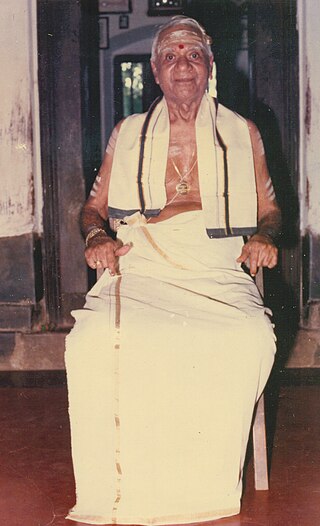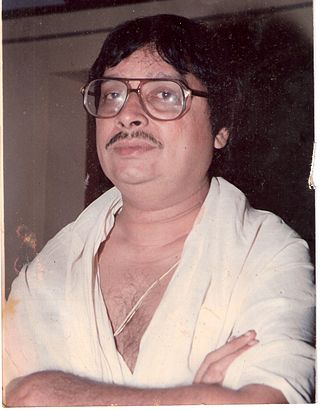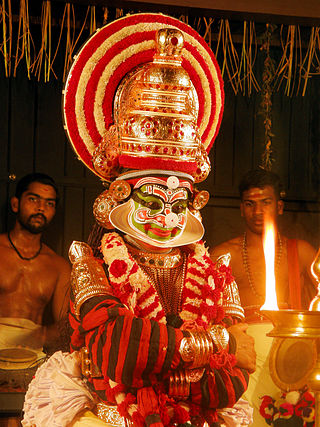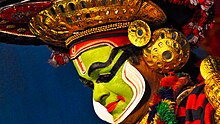
Koodiyattam is a traditional performing art form in the state of Kerala, India. It is a combination of ancient Sanskrit theatre with elements of Koothu, an ancient performing art from the Sangam era. It is officially recognised by UNESCO as a Masterpiece of the Oral and Intangible Heritage of Humanity.

Mani Damodara Chakyar is a Kutiyattam and Chakyar Koothu artist in Kerala state of south India. He is a nephew and disciple of legendary guru Nātyāchārya Vidūshakaratnam Padma Shri Māni Mādhava Chākyār. He belongs to the great Mani Chakyar tradition of Koodiyattam and Chakyar koothu.

Guru Mani Madhava Chakyar (15 February 1899 – 14 January 1990) was a celebrated master performance artist and Sanskrit scholar from Kerala, India, considered to be the greatest Chakyar Koothu and Koodiyattam artist and authority of modern times. He was considered as the authority of Abhinaya and Nātyaśāstra.

Chakyar Koothu is a performance art from Kerala, India. It is primarily a type of highly refined monologue where the performer narrates episodes from Hindu epics and stories from the Puranas. Sometimes, however, it is also a traditional equivalent of the modern stand-up comedy act, incorporating commentary on current socio-political events.

Vadakke Manalath Govindan Nair popularly known as Kalamandalam Gopi, is an Indian dancer who is an exponent of the classical dance-drama style known as Kathakali.

Nātyakalpadrumam is a book written by Guru Māni Mādhava Chākyār, considered the greatest exponent of Koodiyattam and Abhinaya in Kerala, about all aspects of ancient Sanskrit drama theatre tradition of Kerala—Kutiyattam. It was first published in Malayalam (1975) by Kerala Kalamandalam, with financial assistance of Sangeet Natak Academi, New Delhi. This work serves as a reference to both scholars and students. The entire book is written in the old Sanskrit text style closely following Nātyaśāstra. The structure and content of the book alike illustrate the knowledge of the author in both Sanskrit and Nātyaśāstra. The work received the Kerala Sahitya Academy Award in the year 1975. A Hindi translation has been published by the Sangeet Natak Akademi, New Delhi.
Kalamandalam Krishnan Nair was a Kathakali dancer from Kerala in India.

Kalamandalam Venmani Haridas was an Indian Kathakali musician noted for his rendition of the Kathakali padams for the characters in the classical Kerala dance-drama.Born in Venmani Mana, a Namboodiri mansion of literary repute in Vellarappilly village east of Aluva off Kochi, Haridas developed interest in Kathakali by watching performances of the classical dance-drama in the neighbouring Akavoor Mana. He was taught the basics in music by Mundakkal Sankara Varrier. He learned ´padams´ from stories like Rugmini Swayamvaram and Kuchela Vritham.

Kalamandalam Ramankutty Nair was a performer of Kathakali, who practiced the Kerala art form for more than seven decades.
Gandhi Seva Sadan is a Kathakali institution located in Perur village, some 12 kilometres east of Ottapalam in Palakkad district of north-central Kerala in southern India. It was founded in 1953 by the (late) Gandhian and freedom fighter K. Kumaran, equally known for his unflagging devotion to the promotion of the arts.
Ammannur Madhava Chakyar was a master of Kutiyattam, the classical Sanskrit theatrical form indigenous to Kerala. He is best known for taking the performances from the temple sanctuaries where they were formerly confined and making them public events.

Sadanam Krishnankutty is a performer of Kathakali, a classical dance-drama form of Kerala, South India. A recipient of Kerala State Kathakali award and Kalamandalam fellowship, he has donned a wide range of characters in his acts. He received the Kerala Sangeetha Nataka Akademi Award in 2002, the Sangeet Natak Akademi Award in 2007, Honorary D.litt from Thunchath Ezhuthachan Malayalam University, Thirur, Kerala in 2021 and the Sangeet Natak Akademi Fellowship in 2021.
Ammannur Rajaneesh Chakyar is well known Kutiyattam artist from Thrissur, Kerala, India. He was trained under his grand uncle Padmabhushan Dr. Guru Ammannur Madhava Chakyar. for Fifteen years at Ammannur Gurukulam with the Scholarship from Sangeet Natak Akademi, New Delhi.
Paanivadathilakan P. K. Narayanan Nambiar was an Indian musician, known for his virtuosity in Mizhavu, a traditional percussion instrument and his scholarship in the art of Koodiyattom. He is considered to be one of the masters of Koodiyattom. In 2008, he was awarded Padmashri by Government of India for his services to the art.

Kalamandalam Girija is an Indian Kutiyattam dancer who is a recipient of Indian Government Award by Sangeet Natak Academy for the 2021https://indiaartreview.com/stories/kalamandalam-girija-koodiyattam-painkulam-rama-chakyar/https://indiaculture.gov.in/sites/default/files/events/Kutiyattam%20Card%2020072016.pdfhttps://www.thenewsminute.com/article/breaking-through-koodiyattams-caste-barriers-kalamandalam-girijas-revolutionary-journeyhttps://static.pib.gov.in/WriteReadData/specificdocs/documents/2023/feb/doc2023223162001.pdf. She was trained by Natyakalasarvabhowman Guru Painkulam Rama Chakyar, who played a key role in the renaissance of this genre of Indian Sanskrit Theatre & Dance. Girija was chosen by her Guru to be the first non-Nangiar student to learn Kutiyattam and she became the part of the history as the first Kutiyattam actress to perform the art outside the temple premises. She is an empanelled artist of the ICCR.
Margi Sathi was an exponent of Nangiǎr Kūthu which is a form of performing art derived from Koodiyattam and which is traditionally performed by the female members of the Chakkyar community of Kerala. She was also an accomplished expert in enacting the female characters in Koodiyattam. She has performed extensively within India and abroad. A notable performance was at the UNESCO headquarters in Paris in October 2001 as part of a programme to mark UNESCO's proclamation of Kutiyattam as a "masterpiece of oral and intangible heritage of humanity". Sathi had written the attaprakaram for several Nangiǎr Kūthu performance. The attaprakaram for Sreeramacharitham has been published as a book in 1999. She has also appeared in a few Malayalam movies.

Moozhikkulam Kochukuttan Chakyar (1928–2009) was an exponent of Koodiyattam, a traditional form of Sanskrit theatre from Kerala, which has been recognised by UNESCO as an Oral and Intangible Heritage of Mankind. Born in a family of Koodiyattam performers, in 1928, at Ammannur, a small hamlet near Irinjalakuda, in Thrissur district in the south Indian state of Kerala, Chakyar had his early training in the art form from within his family. Ammannur Madhava Chakyar, a renowned Koodiyattam performer and a Padmabhushan awardee, was his cousin and the two, later, would evolve a new school of performance, popularly known as the Ammannur tradition of Koodiyattam. When Margi, an institution promoting traditional art forms of Kerala, started their Koodiyattam training centre in 1981, he was the first residential guru. The institution imparted training to many aspiring performers which included two sons of Chakyar, Margi Sajeev Narayana Chakiar and Margi Madhu and both of them are known exponents of the art form. In 1998, Chakyar joined Nepathya, a centre for excellence in Kudiyattam, as the Mukhya Acharya, and continued his association with the institution till his last. The Government of India awarded him the fourth highest civilian honour of the Padma Shri, in 2008, for his contributions to Arts. He died in 2009, at the age of 81. He is remembered by an annual festival, Guru Moozhikkulam Kochukuttan Chakyar Memorial Kutiyttam Festival, at Moozhikkulam, a suburb of Kochi where Nepathya is headquartered in, and through orations organised by Nepathya.
Kalamandalam Rama Chakyar is a Koodiyattam artist from Kerala, India.
Kerala Sangeetha Nataka Akademi Award is an award given by the Kerala Sangeetha Nataka Akademi, an autonomous organisation for the encouragement, preservation, and documentation of the performing arts of Kerala, set up by the Department of Cultural Affairs of the Government of Kerala. Instituted in 1962, the awards are given in the categories of music, dance, theatre, other traditional arts, and for contribution/scholarship in performing arts. The award consists of Rs. 30,000, a citation and a plaque. The recipients of the award are also conferred the title Kalasree.

Kalamandalam Sindhu is an Indian Koodiyattam-Nangiar koothu artist from Kerala. An ICCR empaneled artiste, she is the recipient of Kerala Sangeetha Nataka Akademi Award in 2019.















